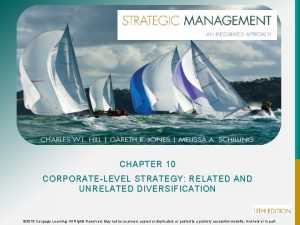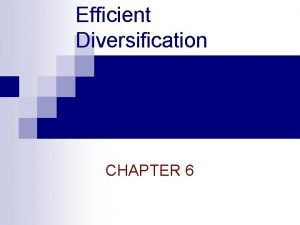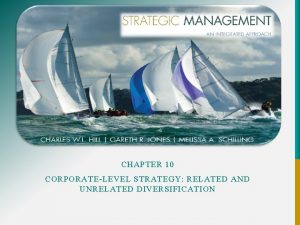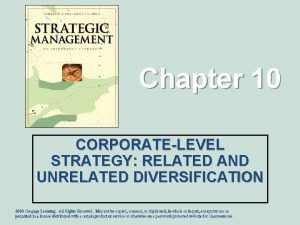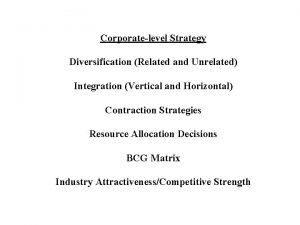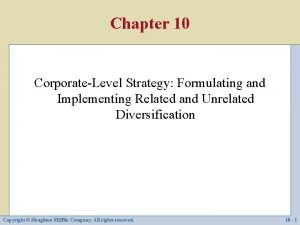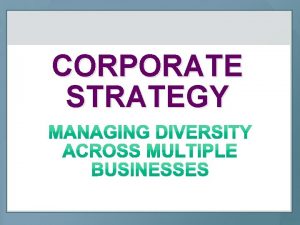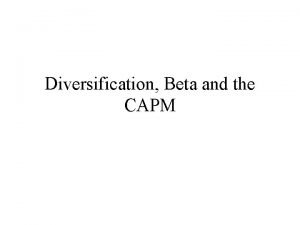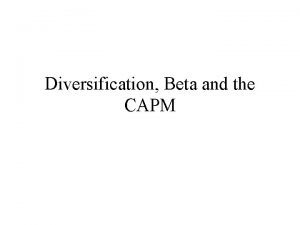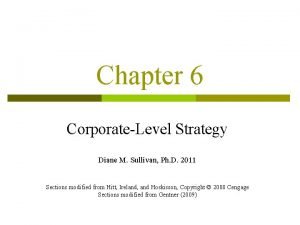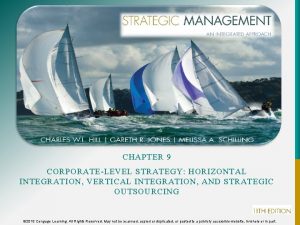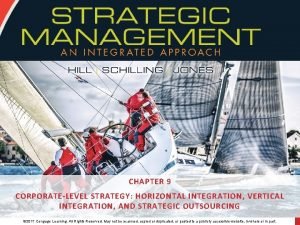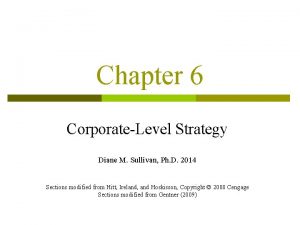CHAPTER 10 CORPORATELEVEL STRATEGY RELATED AND UNRELATED DIVERSIFICATION
































- Slides: 32

CHAPTER 10 CORPORATE-LEVEL STRATEGY: RELATED AND UNRELATED DIVERSIFICATION © 2015 Cengage Learning. All Rights Reserved. May not be scanned, copied or duplicated, or posted to a publicly accessible website, in whole or in part.

LEARNING OBJECTIVES § Differentiate between multibusiness models based on related and unrelated diversification § Explain the five primary ways in which diversification can increase company profitability § Discuss the conditions that lead managers to pursue related diversification versus unrelated diversification and explain why some companies pursue both strategies © 2015 Cengage Learning. All Rights Reserved. May not be scanned, copied or duplicated, or posted to a publicly accessible website, in whole or in part. 2

LEARNING OBJECTIVES § Describe three methods companies use to enter new industries—internal new venturing, acquisitions, and joint ventures—and discuss the advantages and disadvantages associated with each of these methods © 2015 Cengage Learning. All Rights Reserved. May not be scanned, copied or duplicated, or posted to a publicly accessible website, in whole or in part. 3

DIVERSIFICATION § Ways in which profitability can be increased § Transfer competencies between business units in different industries § Leverage competencies to create business units in new industries § Share resources between business units to realize synergies or economies of scope § Use product bundling § Utilize general organizational competencies that increase the performance © 2015 Cengage Learning. All Rights Reserved. May not be scanned, copied or duplicated, or posted to a publicly accessible website, in whole or in part. 4

TRANSFERRING COMPETENCIES § Taking a distinctive competency developed by a business unit in one industry and implanting it in a business unit operating in another industry § Commonality: Skill or competency that when shared by two or more business units allows them to operate more effectively and create more value for customers © 2015 Cengage Learning. All Rights Reserved. May not be scanned, copied or duplicated, or posted to a publicly accessible website, in whole or in part. 5

TRANSFERRING COMPETENCIES § Increase profitability when they: § Lower the cost structure of one or more of a diversified company’s business units § Enable one or more of its business units to better differentiate their products § Distinctive competency being transferred must have real strategic value § Should involve value-chain activities to increases profitability © 2015 Cengage Learning. All Rights Reserved. May not be scanned, copied or duplicated, or posted to a publicly accessible website, in whole or in part. 6

FIGURE 10. 1 - TRANSFER OF COMPETENCIES AT PHILIP MORRIS © 2015 Cengage Learning. All Rights Reserved. May not be scanned, copied or duplicated, or posted to a publicly accessible website, in whole or in part. 7

LEVERAGING COMPETENCIES § Taking a distinctive competency developed by a business unit in one industry and using it to create a new business unit in a different industry § Basis of the model § Company’s competitive advantage in one industry be applied to create a differentiation § Cost-based competitive advantage for a new business unit in a different industry © 2015 Cengage Learning. All Rights Reserved. May not be scanned, copied or duplicated, or posted to a publicly accessible website, in whole or in part. 8

SHARING RESOURCES AND CAPABILITIES § Economies of scope: Synergies that arise when one or more of a diversified company’s business units are able to lower costs or increase differentiation § More effectively pool, share, and utilize expensive resources or capabilities § Sources of cost reductions § Sharing lowers the cost structure § Marketing function does the differentiation of products leading to a higher ROIC © 2015 Cengage Learning. All Rights Reserved. May not be scanned, copied or duplicated, or posted to a publicly accessible website, in whole or in part. 9

PRODUCT BUNDLING § Providing products that are connected to each other § Allows companies to expand their range providing customers a complete package § Goal - Bundle products to offer customers: § Lower prices § Superior set of services § Does not always require joint ownership § Can be achieved through market contracts © 2015 Cengage Learning. All Rights Reserved. May not be scanned, copied or duplicated, or posted to a publicly accessible website, in whole or in part. 10

GENERAL ORGANIZATIONAL COMPETENCIES § Help business units within a company perform at a higher level than it could if it operated as a separate or independent company § Results from the skills of a company’s top managers § Types § Entrepreneurial capabilities § Organizational design capabilities § Strategic capabilities © 2015 Cengage Learning. All Rights Reserved. May not be scanned, copied or duplicated, or posted to a publicly accessible website, in whole or in part. 11

ENTREPRENEURIAL CAPABILITIES § Required to take advantage of the free cash flow § To promote entrepreneurship, a company must: § Encourage managers to take risks § Give managers the time and resources to pursue novel ideas § Not punish managers when a new idea fails § Make sure that the company’s free cash flow is not wasted in risky ventures that would generate a low return on investment © 2015 Cengage Learning. All Rights Reserved. May not be scanned, copied or duplicated, or posted to a publicly accessible website, in whole or in part. 12

CAPABILITIES IN ORGANIZATIONAL DESIGN § Organizational design skills: Ability of the managers to create a structure, culture, and control systems that motivate and coordinate employees to perform at a high level § Major factor that: § Influences a company’s entrepreneurial capabilities § Determines a company’s ability to create functional competencies § Determines a diversified company’s ability to profit from its multibusiness model © 2015 Cengage Learning. All Rights Reserved. May not be scanned, copied or duplicated, or posted to a publicly accessible website, in whole or in part. 13

SUPERIOR STRATEGIC MANAGEMENT CAPABILITIES § Required to manage different business units to perform better than they would if they were independent companies § Ability to diagnose the underlying source of the problems of a poorly performing business unit § Turnaround strategy: Managers of a diversified company identify inefficient and poorly managed companies in other industries © 2015 Cengage Learning. All Rights Reserved. May not be scanned, copied or duplicated, or posted to a publicly accessible website, in whole or in part. 14

SUPERIOR STRATEGIC MANAGEMENT CAPABILITIES § Ways to improve the performance of the acquired company § Top managers of the acquired company are replaced with a more aggressive team § New top-management team sells off expensive assets § New management team works to devise new strategies to improve the performance § Introducing company-wide pay-for-performance bonus system § Establishing stretch goals for employees at all levels © 2015 Cengage Learning. All Rights Reserved. May not be scanned, copied or duplicated, or posted to a publicly accessible website, in whole or in part. 15

RELATED DIVERSIFICATION § Corporate-level strategy based on the goal of establishing a business unit in a new industry related to a company’s existing business units § By some form of commonality or linkage between their value-chain functions § Basis of multibusiness model § Taking advantage of strong commonalities that can be modified to increase the competitive advantage § Allowing a company to use any general organizational competency it possesses © 2015 Cengage Learning. All Rights Reserved. May not be scanned, copied or duplicated, or posted to a publicly accessible website, in whole or in part. 16

UNRELATED DIVERSIFICATION § Corporate-level strategy that uses general organizational competencies to increase the performance of all the company’s business units § Companies pursuing this are called conglomerates § Internal capital market: Corporate-level strategy whereby the firm’s headquarters assesses the performance of business units and allocates money across them © 2015 Cengage Learning. All Rights Reserved. May not be scanned, copied or duplicated, or posted to a publicly accessible website, in whole or in part. 17

UNRELATED DIVERSIFICATION § Benefits of an internal capital market are limited by the efficiency of the external capital market § Reasons for efficiency of capital markets in U. S § Reporting requirements mandated by the Securities and Exchange Commission (SEC) § Large numbers of research analysts § Extremely large and active investment community § Strong communication systems § Strong contract law © 2015 Cengage Learning. All Rights Reserved. May not be scanned, copied or duplicated, or posted to a publicly accessible website, in whole or in part. 18

DISADVANTAGES OF DIVERSIFICATION § Changes in the industry or company § Management § Technology § Diversification for the wrong reasons § Pooling risks § Entry into a wrong business or at wrong time or for wrong reasons © 2015 Cengage Learning. All Rights Reserved. May not be scanned, copied or duplicated, or posted to a publicly accessible website, in whole or in part. 19

DISADVANTAGES OF DIVERSIFICATION § Bureaucratic costs: Costs associated with solving the transaction difficulties between business units and corporate headquarters § Factors responsible § Number of business units in a company’s portfolio § Degree to which coordination is required to realize the advantages of diversification © 2015 Cengage Learning. All Rights Reserved. May not be scanned, copied or duplicated, or posted to a publicly accessible website, in whole or in part. 20

FIGURE 10. 4 - COORDINATION AMONG RELATED BUSINESS UNITS © 2015 Cengage Learning. All Rights Reserved. May not be scanned, copied or duplicated, or posted to a publicly accessible website, in whole or in part. 21

RELATED VERSUS UNRELATED DIVERSIFICATION Related diversification Unrelated diversification • Company’s competencies can be applied across a greater number of industries • Company’s top managers are skilled at raising the profitability of poorly run businesses • Company has superior strategic capabilities that allow it to keep bureaucratic costs under close control • Company’s managers use their strategic management competencies to: • Improve the competitive advantage of their business units • Keep bureaucratic costs under control © 2015 Cengage Learning. All Rights Reserved. May not be scanned, copied or duplicated, or posted to a publicly accessible website, in whole or in part. 22

FIGURE 10. 5 - SONY’S WEB OF CORPORATE-LEVEL STRATEGY © 2015 Cengage Learning. All Rights Reserved. May not be scanned, copied or duplicated, or posted to a publicly accessible website, in whole or in part. 23

INTERNAL NEW VENTURING § Transferring resources and creating a new business unit in a new industry to innovate new kinds of products § Used by companies that are: § Technology-based and pursue related diversification § Venturing to enter a newly emerging industry § Pitfalls § Market entry on too small a scale § Poor commercialization of the new-venture product § Poor corporate management of new-venture division © 2015 Cengage Learning. All Rights Reserved. May not be scanned, copied or duplicated, or posted to a publicly accessible website, in whole or in part. 24

FIGURE 10. 6 - SCALE OF ENTRY AND PROFITABILITY © 2015 Cengage Learning. All Rights Reserved. May not be scanned, copied or duplicated, or posted to a publicly accessible website, in whole or in part. 25

GUIDELINES FOR SUCCESSFUL INTERNAL NEW VENTURING § Understanding and basing new ventures on R&D § Giving funding for research to business unit managers who can narrow down and then select the best set of research projects § Work with R&D scientists to continually develop and improve the business model and strategies § Fostering links between R&D and marketing to the commercial success of the new product will © 2015 Cengage Learning. All Rights Reserved. May not be scanned, copied or duplicated, or posted to a publicly accessible website, in whole or in part. 26

GUIDELINES FOR SUCCESSFUL INTERNAL NEW VENTURING § Fostering links between R&D and manufacturing to ensure cost-effective manufacturing of the product § Construct efficient-scale manufacturing facilities and give marketing a large budget § To develop a future product campaign that will build market presence and brand loyalty quickly © 2015 Cengage Learning. All Rights Reserved. May not be scanned, copied or duplicated, or posted to a publicly accessible website, in whole or in part. 27

ACQUISITIONS § Principal way companies enter new industries to pursue vertical integration and diversification § Used by companies to move fast to establish a presence in an industry § Less risky than internal new ventures § Easy way to enter an industry that is protected by high barriers to entry © 2015 Cengage Learning. All Rights Reserved. May not be scanned, copied or duplicated, or posted to a publicly accessible website, in whole or in part. 28

ACQUISITION Pitfalls • • Integrating the acquired company Overestimating economic benefits Expense of acquisitions Inadequate pre-acquisition screening Guidelines for success • • Target identification and pre-acquisition screening Bidding strategy Integration Learning from experience © 2015 Cengage Learning. All Rights Reserved. May not be scanned, copied or duplicated, or posted to a publicly accessible website, in whole or in part. 29

JOINT VENTURES § Two or more companies agree to pool their resources to create new business § Allows a company to share the risks and costs associated with establishing a business unit § Resulting problems § Partner with superior skills will have to give away profits § Different business models or time horizons leading to a conflict about how to run the joint venture © 2015 Cengage Learning. All Rights Reserved. May not be scanned, copied or duplicated, or posted to a publicly accessible website, in whole or in part. 30

RESTRUCTURING § Reorganizing and divesting business units and exiting industries § To refocus upon a company’s core business and rebuild its distinctive competencies § Reasons § Investors feel these companies no longer have multibusiness models © 2015 Cengage Learning. All Rights Reserved. May not be scanned, copied or duplicated, or posted to a publicly accessible website, in whole or in part. 31

RESTRUCTURING § Complexity of the financial statements of highly diversified enterprises disguises the performance of individual business units § Response to declining financial performance brought about by over-diversification § Diminished advantages of vertical integration or diversification from innovations in strategic management © 2015 Cengage Learning. All Rights Reserved. May not be scanned, copied or duplicated, or posted to a publicly accessible website, in whole or in part. 32
 Company diversification strategy
Company diversification strategy Related and unrelated diversification
Related and unrelated diversification Related and unrelated diversification
Related and unrelated diversification A strategy of diversifying into unrelated businesses
A strategy of diversifying into unrelated businesses Samsung unrelated diversification strategy
Samsung unrelated diversification strategy A strategy of diversifying into unrelated businesses
A strategy of diversifying into unrelated businesses Why are related forms more agreeable than unrelated forms?
Why are related forms more agreeable than unrelated forms? Why are related forms more agreeable than unrelated forms
Why are related forms more agreeable than unrelated forms Why are related forms more agreeable than unrelated forms?
Why are related forms more agreeable than unrelated forms? What is related constrained diversification
What is related constrained diversification What is related constrained diversification
What is related constrained diversification Retrenching to a narrower diversification base is
Retrenching to a narrower diversification base is Economic diversification drive strategy botswana
Economic diversification drive strategy botswana Volkswagen grouo
Volkswagen grouo 2 types of fitness
2 types of fitness Skill related fitness
Skill related fitness Portfolio diversification
Portfolio diversification Adding new, unrelated products or services
Adding new, unrelated products or services Unrelated t test
Unrelated t test Minor supporting sentence
Minor supporting sentence Unrelated t test
Unrelated t test Adding new unrelated products or services
Adding new unrelated products or services Abct guidelines nursing
Abct guidelines nursing On an unrelated note
On an unrelated note Translation by more neutral/less expressive word
Translation by more neutral/less expressive word Which of the following pairs contains unrelated items?
Which of the following pairs contains unrelated items? A single str may differ between two unrelated people by
A single str may differ between two unrelated people by A single str may differ between two unrelated people by
A single str may differ between two unrelated people by Mood in poetry examples
Mood in poetry examples Intensive integrative and diversification growth strategies
Intensive integrative and diversification growth strategies Intensive integrative and diversification growth strategies
Intensive integrative and diversification growth strategies Antibody diversification
Antibody diversification Diversification de redéploiement
Diversification de redéploiement


